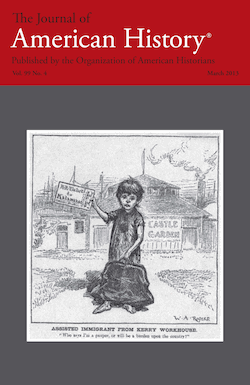Teaching the Article
Day 1: Consuming Crude
In its various forms, petroleum enabled humans to overcome limits, particularly those of time and space. In People of Plenty, David Potter discussed the historical tradition of American expansion and restlessness in this fashion: “The man best qualified for this role was the completely mobile man, moving freely from one locality to the next, from one economic position to another, or from one social level to levels above.” In addition to ensuring physical movement, Potter’s description also includes the economic and social mobility that petroleum helped to bring Americans through mass consumption. Dovetailing with new information technologies and advancements in production capabilities, petroleum became a primary component in allowing producers to overcome limits of supply and production. Their success, then, allowed for massive growth in the scale of production and, ultimately, in mass production, which brought prices down and made a whole world of products and services available to middle class American consumers. In short, David Potters’ “People of Plenty” prioritized their ease and standard of living over almost every other concern.
Inexpensive petroleum proved to be one of the most essential raw materials in this new model of consumption. In many historical patterns, though, petroleum went unnoticed–its availability at inexpensive prices assumed. Use the exercises below to find cheap crude in some of the basic patterns of American mass consumption after World War II.
Exercise 1: Babbit
When Sinclair Lewis created George Babbitt, the protagonist of his novel Babbit, he also created a representative for a new model of American living that emerged between the World Wars, primarily in the 1920s. With his representative role in mind, read the first few pages of Chapter 3 before answering the questions below.
Questions
- What are the aspects of George Babbitt’s life in the 1920s that make him a “modern man”?
- What role does consumption play in this society?
- Is energy important to this model of human life?
Source
Exercise 2: World’s Fair 1939
Although World War II briefly interceded, the World’s Fair of 1939 near New York City formed a vision of the future that–although containing a healthy dose of imagination—proved remarkably accurate in many of the basic forces that it believed would frame American life.
Questions
- In what ways is energy required for the model society depicted at this event?
Sources
Exercise 3: Public Law 106-45
Roads were the infrastructure that made petroleum useful for transportation; however, that doesn’t mean it was all about utility. The fun and adventure of the open road attracted many Americans. Iconic highways such as Route 66 became symbols of our Automobile era powered by cheap petroleum. But how can historical preservation tell this story?
Over the last few decades, the National Park Service (NPS) has struggled with how best to preserve a record of this aspect of American life. Specifically, Route 66, as the nation’s most iconic roadway, has forced the NPS to consider both the important of roads in American life and also the complexities of appropriately preserving one. Public Law 106-45, which was passed in 1999, was one product of this long process. Review it before responding to the questions below. You may also wish to review the additional site in order to add historical context to your knowledge of Route 66.
Questions
- What was particularly important about roads such as Route 66 after World War II?
- What role did they play for specific communities? For the nation in general?
- Why is preserving this site particularly challenging?
Sources
Exercise 4: FILM: Destination Earth, 1956
Particularly in the 1950s, science fiction films offer a particularly revealing source for understanding American culture. Often, just below the surface of their narratives of enlarged insects or dinosaurs, the storylines barely hide society-wide anxieties about nuclear attack, invasion, or an unbalanced relationship with nature. Destination Earth is much more overt in its use of alien observers of the emerging American society. View the film as a class and then respond to the questions below.
Questions
- Who made the film?
- What is their goal?
- How is life in America depicted?
- Although this is a fictional account, is there truth to its depiction of American living patterns? Explain your response.
Sources
Exercise 5: O Winston Link’s photograph, Hot Shot Eastbound
In these exercises, we have broadly considered the sociological and economic impacts enabled by cheap petroleum. As you study O Winston Link’s photograph, Hot Shot Eastbound, (Laeger, West Virginia, 1956), consider the broad changes that have taken shape in this society after World War II. Use this image as a snapshot portrait of a unique America that has emerged.
Questions
- Using this image as a starting point, what are three patterns of life made possible by crude that have emerged after 1920?
